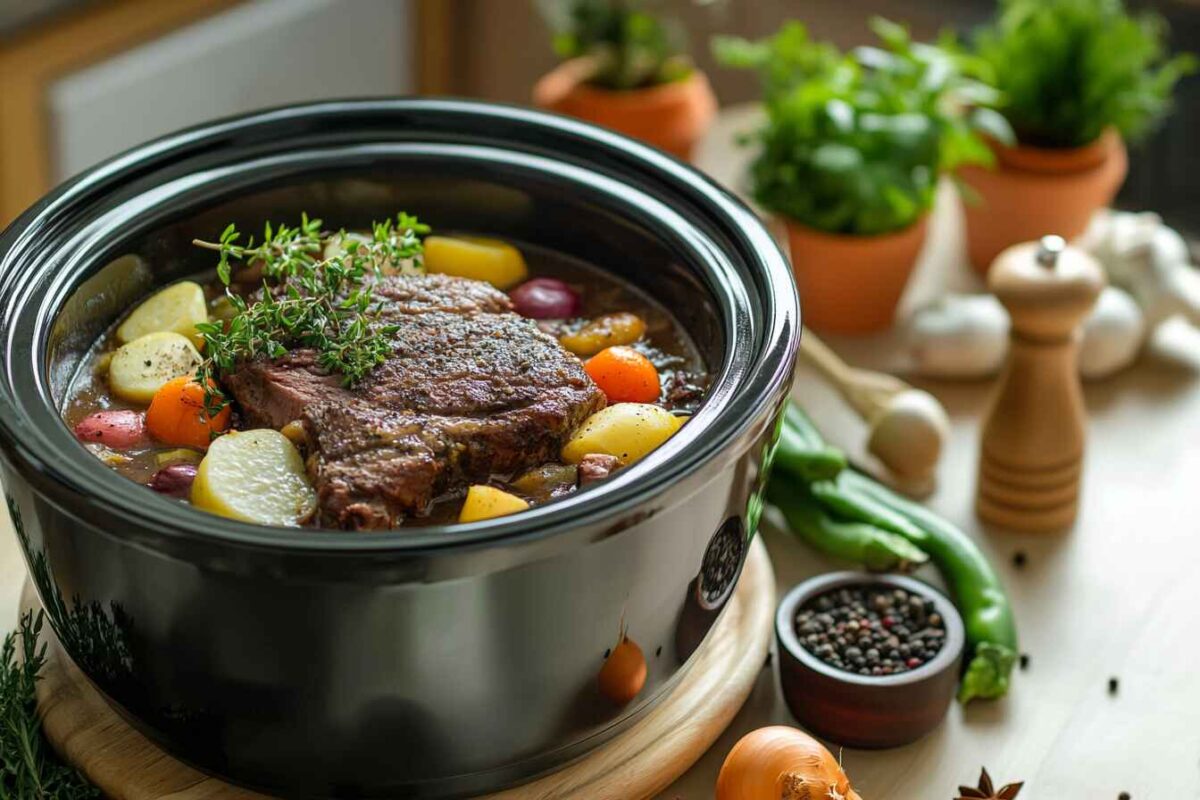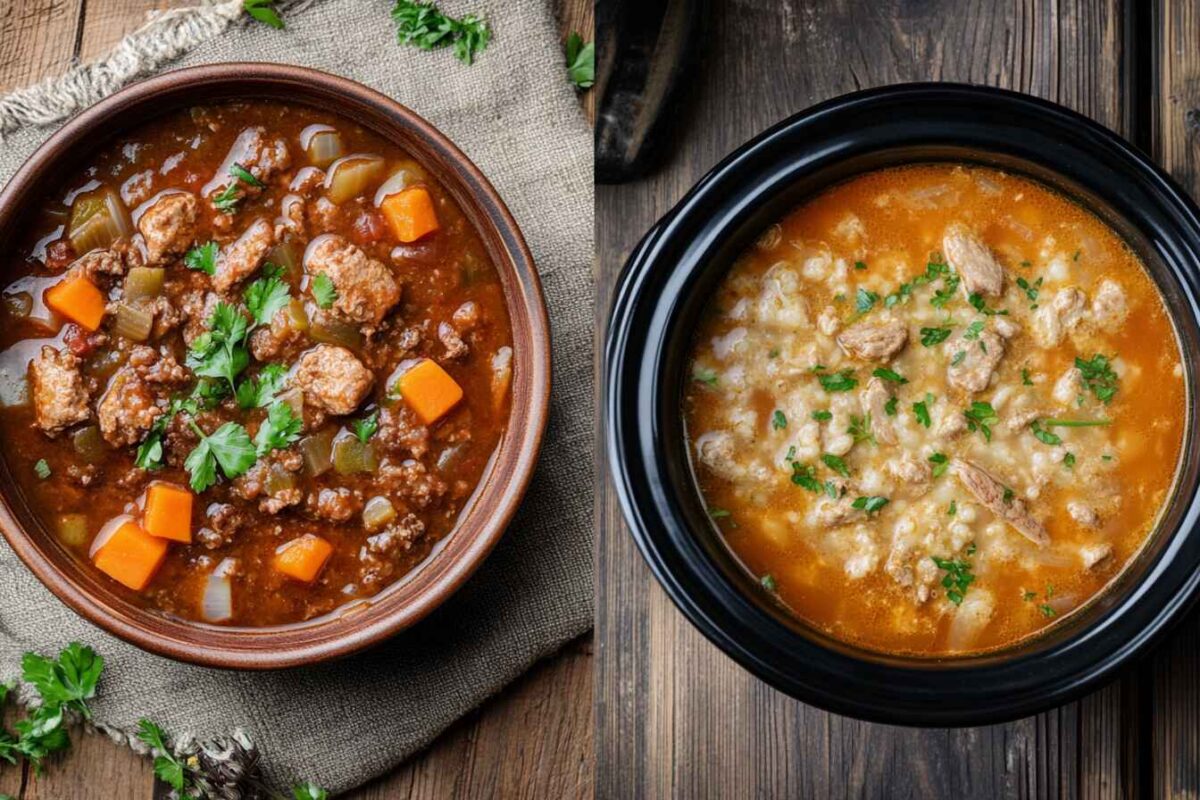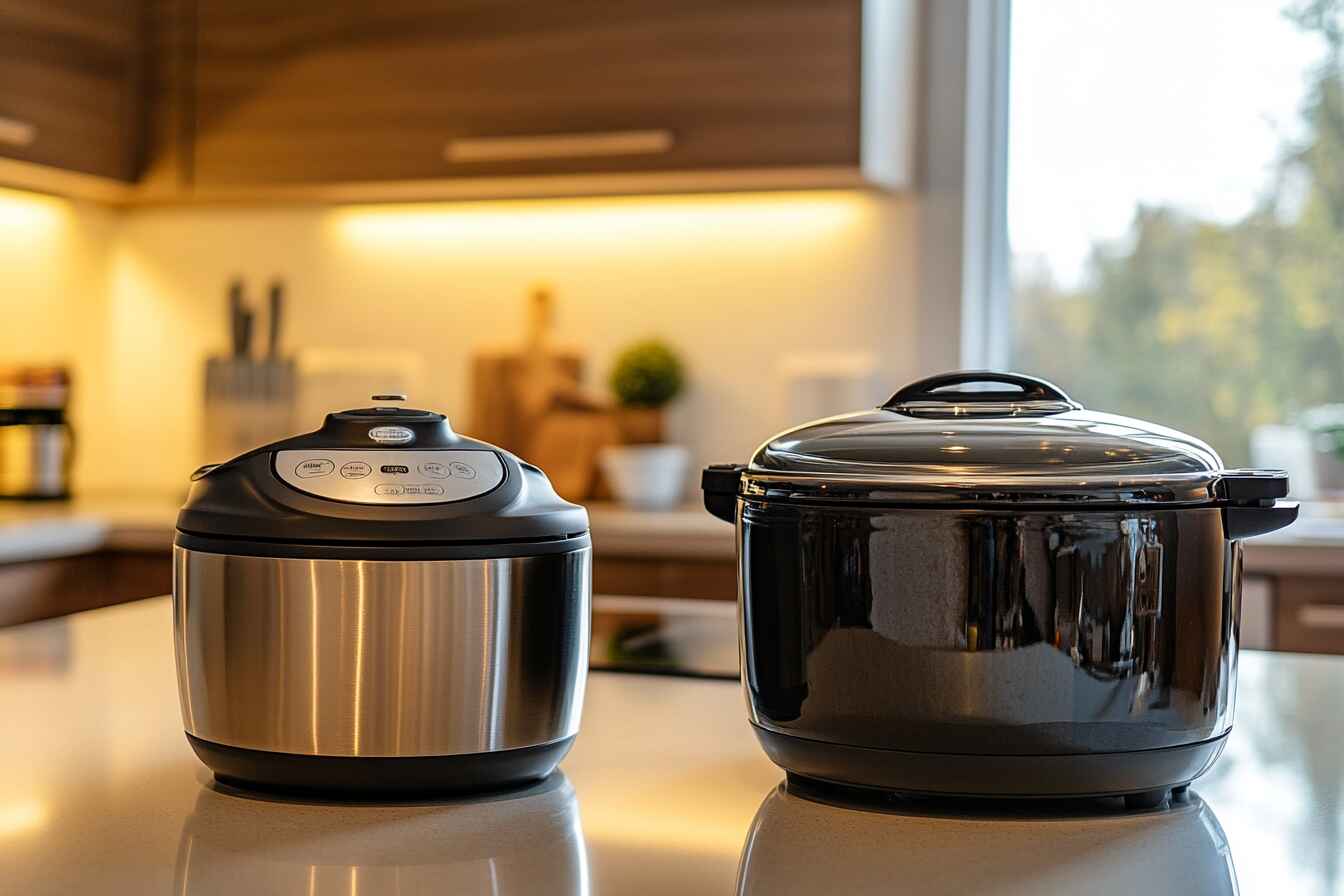What is the difference between a slow cooker and a Crockpot? These two appliances are staples in kitchens worldwide, offering a convenient way to prepare delicious, slow-cooked meals. While many people use these terms interchangeably, there are distinct differences between them. Understanding these differences can help you choose the right appliance for your culinary needs.
In this article, we’ll dive into the world of slow cookers and Crockpots, exploring their histories, features, and functionalities. By the end, you’ll have a clear grasp of what sets these appliances apart and how to choose the best one for your kitchen.
Table of Contents
What Is the Difference Between a Slow Cooker and a Crockpot?
What Are Slow Cookers and Crockpots?
At their core, slow cookers and Crockpots are appliances designed to cook food slowly over low heat. They’re ideal for soups, stews, casseroles, and even desserts. However, the term “Crockpot” refers to a specific brand of slow cooker, first introduced by the company Rival in the 1970s. Over time, “Crockpot” became synonymous with slow cookers, much like “Kleenex” is often used for tissues.
While all Crockpots are slow cookers, not all slow cookers are Crockpots. This distinction lies in the design, heating mechanism, and trademarked technology of the Crockpot brand, setting it apart from generic slow cookers.
History and Evolution of Slow Cooking Appliances
The slow cooker concept dates back to the early 20th century, with predecessors like bean pots and braising pans. The modern slow cooker, however, was revolutionized by the introduction of the Crockpot in 1971. Its success was largely due to its convenience—home cooks could start meals in the morning and return to a hot, ready-to-serve dish after a long day.
As technology advanced, slow cookers evolved to include programmable settings, digital displays, and multi-cooking functions, making them even more versatile and user-friendly.
Why Understanding the Difference Matters
Choosing between a slow cooker and a Crockpot isn’t just about brand loyalty—it’s about finding an appliance that suits your cooking style. For instance, some dishes may fare better in a Crockpot due to its unique heating method, while a generic slow cooker might be more affordable for everyday use. By knowing the nuances, you can make a smarter, more informed decision.
Overview of Slow Cookers
Definition and Primary Purpose of Slow Cookers
A slow cooker is a versatile kitchen appliance designed to cook food slowly at a consistent low temperature. It typically includes a ceramic or metal pot placed inside a heated base, topped with a tight-fitting lid to trap moisture. Slow cookers are excellent for preparing hearty meals like soups, stews, and braises, as their steady heat allows flavors to develop over time.
Unlike some specialized appliances, slow cookers are non-branded and come in various designs and functionalities. Their straightforward design makes them a go-to for cooks who want simple, reliable, and hands-off cooking solutions.
Key Features of Slow Cookers
Slow cookers are known for their simplicity and adaptability. Here’s what sets them apart:
- Temperature Settings: Most slow cookers come with basic settings like low, high, and warm. This allows flexibility for different recipes, whether you’re simmering a sauce or fully cooking a roast.
- Removable Inserts: Many models feature ceramic or metal pots that can be easily removed for serving and cleaning.
- Cooking Versatility: From breakfast casseroles to tender meats, slow cookers handle a wide variety of recipes.
- Size Options: Slow cookers range from small 2-quart models for single servings to large 8-quart versions for family meals.
Advantages of Using a Slow Cooker
Slow cookers are a game-changer for busy households. They save time by letting you prep ingredients in the morning and return to a fully cooked meal. Additionally, they’re energy-efficient, often using less electricity than an oven. With their low-maintenance design, slow cookers simplify meal prep while delivering restaurant-quality results.
Popular Brands and Variations of Slow Cookers
While Crockpot dominates the conversation, there are many reputable slow cooker brands, including Hamilton Beach, Instant Pot, and Cuisinart. Each offers unique features like programmable timers, multi-cooking options, and modern designs to fit any kitchen style.
Overview of Crockpots
What Makes a Crockpot Unique?

A Crockpot is a specific type of slow cooker that stands out due to its patented design and heating mechanism. Developed by the Rival company, the Crockpot uses a ceramic or stoneware pot that heats from both the sides and bottom. This even heat distribution ensures consistent cooking, making it ideal for recipes requiring precise temperature control.
While all Crockpots are slow cookers, their unique features give them an edge in certain culinary applications.
Key Features of a Crockpot
Crockpots offer several advantages that set them apart from generic slow cookers:
- Patented Heating Method: Unlike standard slow cookers that primarily heat from the bottom, Crockpots provide even heating from all sides.
- Durable Stoneware Pot: The removable stoneware insert is sturdy, retains heat well, and is easy to clean.
- Locking Lids: Many models feature locking lids, making them perfect for transporting meals to potlucks or family gatherings.
- Enhanced Temperature Control: Modern Crockpots often include digital controls for precise heat adjustments and timers.
Advantages of Crockpots for Specific Cooking Needs
Crockpots are especially good at slow-cooking tougher cuts of meat, as their even heating breaks down connective tissues to create tender, juicy dishes. Additionally, their controlled cooking environment reduces the risk of burning or uneven cooking, making them ideal for delicate recipes like custards or desserts.
The History of the Crockpot Brand
The Crockpot’s story began in 1971 when Rival introduced the original model, targeting busy homemakers who needed convenient meal solutions. Over the decades, the brand became synonymous with slow cooking, cementing its place as a household name. Today, Crockpots are available in various models, from basic manual versions to high-tech, Wi-Fi-enabled designs.
What Is the Difference Between a Slow Cooker and a Crockpot: Key Differences
Structural and Functional Differences: Slow Cooker vs. Crockpot
Understanding what is the difference between a slow cooker and a Crockpot begins with their design and functionality. While both appliances serve the same purpose, their construction varies:
- Heating Mechanism: A Crockpot heats food from the sides and bottom, ensuring even cooking. In contrast, many slow cookers heat from the bottom only, which can result in slight hot spots.
- Material and Design: Crockpots often feature a durable stoneware insert, while generic slow cookers may use ceramic or even metal pots.
- Shape and Size Options: Crockpots are often oval, ideal for roasts or larger cuts of meat, whereas slow cookers are available in both round and oval shapes for various recipes.
Cooking Performance: What Is Better for a Slow Cooker or Crockpot?

When it comes to cooking specific dishes, the choice between these appliances can matter. Crockpots excel at recipes requiring even, consistent heat over long periods, such as braised meats or creamy soups. Slow cookers, on the other hand, work well for soups, stews, and casseroles where precise heat distribution is less critical.
For example, if you’re making chili or pulled pork, both appliances perform well. However, for recipes like delicate custards or bread pudding, the even heat of a Crockpot may yield better results.
Ease of Use and Maintenance Comparison
Both appliances are easy to use, but there are some notable differences:
- Ease of Use: Crockpots with programmable timers and locking lids offer added convenience. Many slow cookers rely on manual dials, which might require more monitoring.
- Cleaning and Durability: Crockpot’s stoneware inserts are typically dishwasher-safe and scratch-resistant, whereas some slow cookers might have non-stick coatings that require gentle care.
Price and Availability: Crockpots vs. Generic Slow Cookers
In terms of cost, generic slow cookers tend to be more budget-friendly, with basic models starting as low as $20. Crockpots, given their advanced features and brand reputation, are slightly pricier, often ranging from $30 to $150, depending on the model.
If affordability is your priority, a generic slow cooker might suffice. However, investing in a Crockpot could be worthwhile if you frequently cook dishes requiring even heat.
How to Choose Between a Slow Cooker and a Crockpot
Factors to Consider: Cooking Habits, Dish Preferences, and Budget
When deciding between these appliances, consider your cooking style and needs. If you enjoy making large roasts, creamy soups, or dishes requiring precise temperature control, a Crockpot may be ideal. However, if you’re looking for an affordable, no-frills option for everyday meals, a slow cooker works just fine.
When a Slow Cooker Might Be the Better Choice
A generic slow cooker is great for:
- Beginners or those new to slow cooking.
- People looking for a cost-effective solution.
- Simple recipes like soups, stews, and casseroles.
Its straightforward design makes it a dependable option for everyday cooking.
When a Crockpot Shines for Your Needs
A Crockpot stands out for:
- Cooks who value even heat distribution for complex recipes.
- Families or hosts who need portable features, like locking lids.
- Recipes requiring long cooking times, like brisket or pot roasts.
While a bit pricier, Crockpots often justify their cost with added durability and convenience.
FAQs
Which Is Better, a Crockpot or a Slow Cooker?
This depends on your needs. A Crockpot’s even heat distribution and durable design make it perfect for recipes requiring precise cooking, like roasts or custards. However, a generic slow cooker is a more affordable option and works well for everyday meals like stews or casseroles.
Can I Use a Slow Cooker as a Crockpot?
Yes, you can use a slow cooker in place of a Crockpot for most recipes. However, keep in mind that the heating mechanism might differ slightly. For example, if your slow cooker only heats from the bottom, you may need to stir occasionally to avoid uneven cooking.
What Foods Should Not Go in a Slow Cooker?
While slow cookers and Crockpots are incredibly versatile, some foods don’t cook well in them:
Dairy Products: Milk, cream, and cheese can curdle if cooked for too long.
Seafood: Delicate seafood like shrimp can overcook quickly and turn rubbery.
Pasta: Adding pasta too early can cause it to become mushy. It’s better to cook it separately and add it at the end.
Why Do They Call It a Crockpot?
The name “Crockpot” comes from its original design. The appliance featured a “crock,” or ceramic pot, inside a heated base. Rival trademarked this term when they introduced their slow cooker model in the 1970s, and it has since become synonymous with slow cooking appliances.
Pro Tip: For more high-protein meal ideas using your slow cooker, check out this article on Slow Cooker Secrets: High-Protein Recipes You’ll Love.

